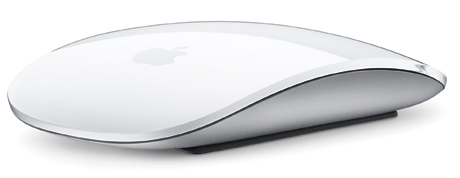I recently got to use one for a day of design work, web surfing, and general computing, and got my answer. The Magic Mouse is compact, and glides smoothly on your desk. The cursor was very responsive, and not the least bit “jumpy” on any surface I tried it on, including my lap. But that’s pretty much where the love affair ended for me. 
With the exception of Apple’s iMac hockey-puck mouse years ago, I can’t recall ever using a more uncomfortable mouse in my 20-plus years of computing.
The very thing that makes it so stunning to look at also makes it so uncomfortable to use. After about an hour of working in Photoshop and InDesign, my hand was cramped from squeezing it. It’s just too low-profile for long-term use. I felt like I had to work too hard to keep control of it. While the touch clicking and scrolling was easy enough, using the limited gestures available was virtually impossible for me. I simply couldn’t hold the mouse and swipe at the same time without contorting my hand to the point of causing more cramps in my fingers. The amount of time wasted trying to get the gestures to work could be accomplished the old-fashioned way. Of course, nobody says you MUST use the Magic Mouse for your daily computing needs. Due to its compact size and Bluetooth connection, the Magic Mouse makes a great compliment to your MacBook Pro when you’re on the road. It’s also fine for users who may not require a lot of mousing around, such as writers or anyone who makes extensive use of the keyboard vs. the mouse. At $69 though, the Magic Mouse is awfully expensive for a “backup” mouse.

My thumb and fourth finger naturally sit right on the sharp edged corner of the mouse which is actually very uncomfortable. Have just had to switch back to a regular mouse. Comfort should be one of the most important factors on a mouse.
The rails on the bottom of the mouse, on which the mouse is supposed to glide, are not the smooth hard surface that you find on the average mouse. My are wearing down. Magic Mouse’s rails are so small, that the metal bottom of the mouse rubs against the surface of my desktop. The gray paint has worn off, leaving a dark find powder all over the desk, which in turn gets transferred by my fingers on to the keyboard. There’s now a shiny metal oval scraped away on the bottom of the mouse. Furthermore, the right-click fails often. I like the way scrolling works, but it’s not worth the hassle.
buy Microsoft ARC mouse… folds so easy to take on the road…the most confortable mouse ever. i never used my magic mouse ever again with my macbook pro.
Check out this video that has a solution for the lack of comfort caused by extended usage of the magic Mouse-
I agree with uou! And the sharp edges are uncomfortable. I find I try to not hold onto it whenever possible. I would buy a different mouse.
I totally agree with you. And more..
I totally agree with you!
Thanks!